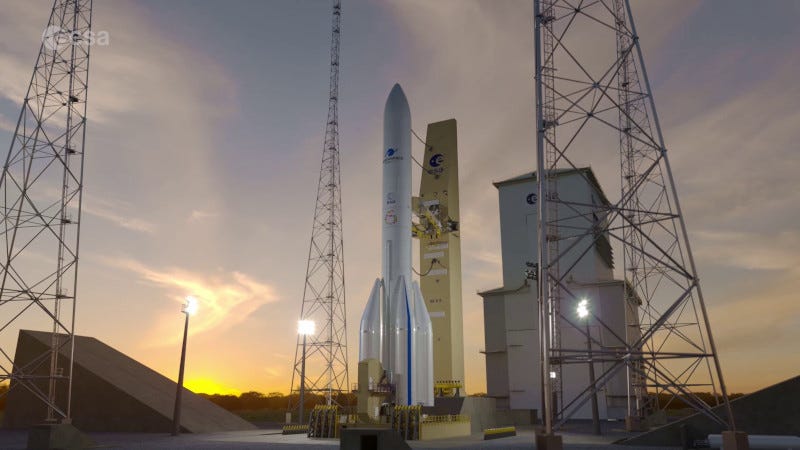Ariane 6 Passes All Qualification Tests
Test Article Removed from Launch Pad, Making Way for Flight Vehicle
Europe’s newest launch system, Ariane 6, has passed all its qualification tests in preparation for its first flight, and the full-scale test model has been removed from the launch pad to make way for the real rocket that will ascend to space.
The test model at Europe’s Spaceport in Kourou, French Guiana, stood 62 m (310 feet) high. It is exactly the same as the ‘production model’ Ariane 6 rockets that will soon be launched, except that its boosters do not need to be tested as part of the complete rocket, so the boosters are not fuelled.
Teams preparing Ariane 6 for its inaugural flight successfully completed for the first time a launcher preparation and countdown sequence, on July 18. Representatives of ESA, Ariane 6 prime contractor ArianeGroup and launch base prime contractor and test conductor CNES completed important objectives for system qualification and performed a series of actions fully representative of a launch chronology.
The launch simulation included the removal of the mobile gantry, the chill-down of ground and launcher fluidic systems, the filling of the upper and core stage tanks with liquid hydrogen (–253°C) and liquid oxygen (–183°C), and at the end of the test, the successful completion of a launch chronology up to the ignition of the Vulcain 2.1 engine thrust chamber by the ground system.
On September 5, 2023 the Vulcain 2.1 engine was ignited, fired for four seconds as planned and switched off before its liquid oxygen and liquid hydrogen fuels were drained to their separate underground tanks. The exercise showed again that the system can be kept safe in the event of a launch abort, as already demonstrated during the 18 July test.
A nighttime full-scale wet rehearsal for Ariane 6 was completed on October 24, 2023, the rocket was fuelled and then drained of its fuel. The test lasted over 30 hours with three teams working in shifts of 10 hours each.
A major full-scale rehearsal was conducted on November 23, 2023 in preparation for its first flight, when teams on the ground went through a complete launch countdown followed by a seven-minute full firing of the core stage’s engine, as it would fire on a launch into space.
A third combined test loading occurred on December 15, 2024 that included a launch countdown to qualify the launch system in degraded conditions and ensure its robustness in preparation for operations. This test sequence included qualification tests of several launch system functions in case of aborted launch and included one ignition of the Vulcain 2.1 engine thrust chamber. It was the fifth countdown run to include loading Ariane 6 with cryo-propellants since July.
On January 30, 2024, the cryogenic connection system passed a last system test of the liftoff disconnection operations lines – the yellow arms supporting the fuel lines to the upper stage to power the Vinci orbital engine. Simultaneously at the bottom of the central core the connection system for the main stage also disconnected.
On February 5, it was the turn of the electrical umbilical lines to be disconnected. These lines supply the launcher and the satellites inside Ariane 6 with electrical power but also host the digital signals for communications with the informatics system as well as carrying sensor information to ensure the flight system is in good shape for liftoff.
The largest components for the first flight model of Europe’s new rocket Ariane 6 arrived at the port of Pariacabo in Kourou, French Guiana on 21 February 2024 via the novel ship, Canopée (canopy in French). The Ariane 6 stages and components are all manufactured across Europe.
The two central stages for Ariane 6’s first flight were then assembled in the launcher assembly building (BAL) at Europe’s Spaceport. The core stage and the upper stage for Europe’s new rocket Ariane 6 are set to fly in the Summer of 2024. Once assembled, the stages will be transferred to the launch pad.






